An Illustrated History of Old Sutton in St Helens, Lancashire
Part 38 (of 95 parts) - Sutton Crime & Court Cases - Part 1
Indecent Behaviour in a Churchyard | Two Candidates for Ragged School | Trouble at Rolling Mill
Raid on the Sutton 'Tossers' | The Drunken Hearse Driver | The Shooting of a Bold Poacher
Great St.Helens Railway Robbery | The Attempted Axe Murder of a Stepfather at St Helens
Also See Pages: Sutton Crime Part 2 | Sutton Crime Part 3 (in brief) | Sutton Tragedy Part 1
Researched and Written by Stephen Wainwright ©MMXX Contact Me
Irish Terrorism in Sutton
Midnight Coup in Lancashire
Indecent Behaviour in a Churchyard
Two Candidates for Ragged School
Trouble at the Rolling Mill
The Raid on the Sutton 'Tossers'
The Drunken Hearse Driver
The Shooting of a Bold Poacher
The Great St.Helens Railway Robbery
Attempted Axe Murder of a Stepfather
Researched & Written by Stephen Wainwright ©MMXX
Old Sutton in St Helens
Irish Terrorism in Sutton
Midnight Coup in Lancashire
Indecent Behaviour in…
Ragged School Candidates
Trouble at the Rolling Mill
The Raid on Sutton Tossers
The Drunken Hearse Driver
Shooting of a Bold Poacher
Great St.Helens Robbery
Attempted Axe Murder…
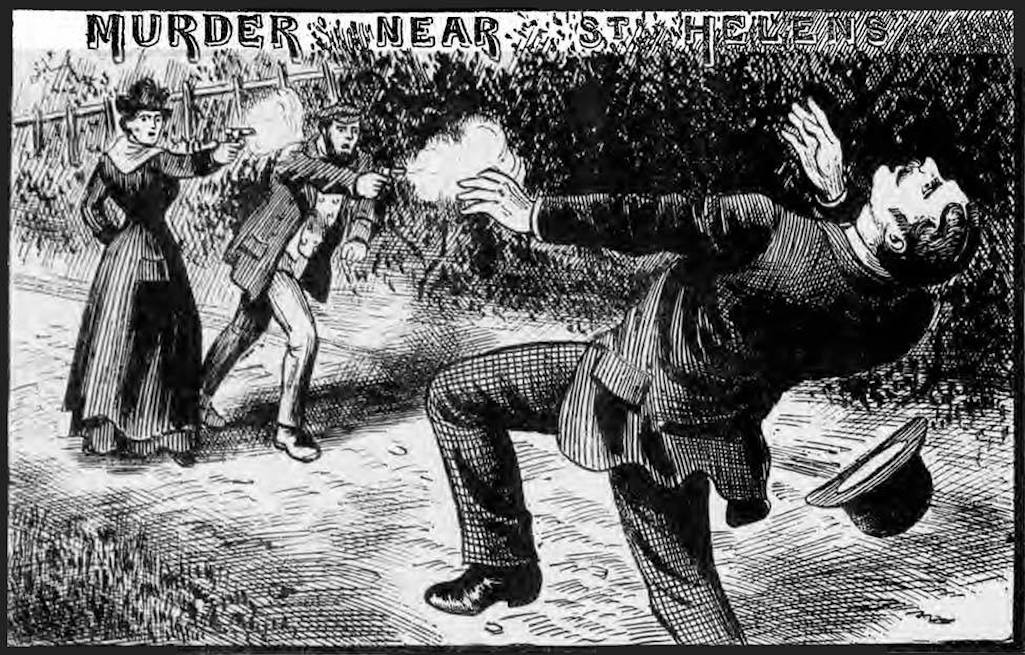
Murder & Suicide on a Train
'Murder and Suicide' was the headline in The Times's edition of September 23rd 1871, which was followed on the 25th and 30th of that month with lengthy reports of the witness statements that were made at the coroner's inquest. The reports revealed how 33-year-old unemployed surveyor, Robert Wanless of Sutton, had shot his wife Ann in the temple whilst the pair were travelling on the Liverpool train. After killing his wife in cold blood, he then put the revolver into his mouth and pulled the trigger.Thirty-two year-old Wanless, had lost his job and his marriage was on the rocks. So he moved in with his brother William who was a miner living in Sutton Oak. On the 21st September, he met up with his estranged wife Ann who was staying in Pemberton, near Wigan and they caught a train together. Shortly after passing through Rainford Junction, Thomas Young, a Farnworth cooper and fellow second-class passenger, heard sounds of a struggle followed by two shots and then a silence that was accompanied by a pungent smell of gunpowder.
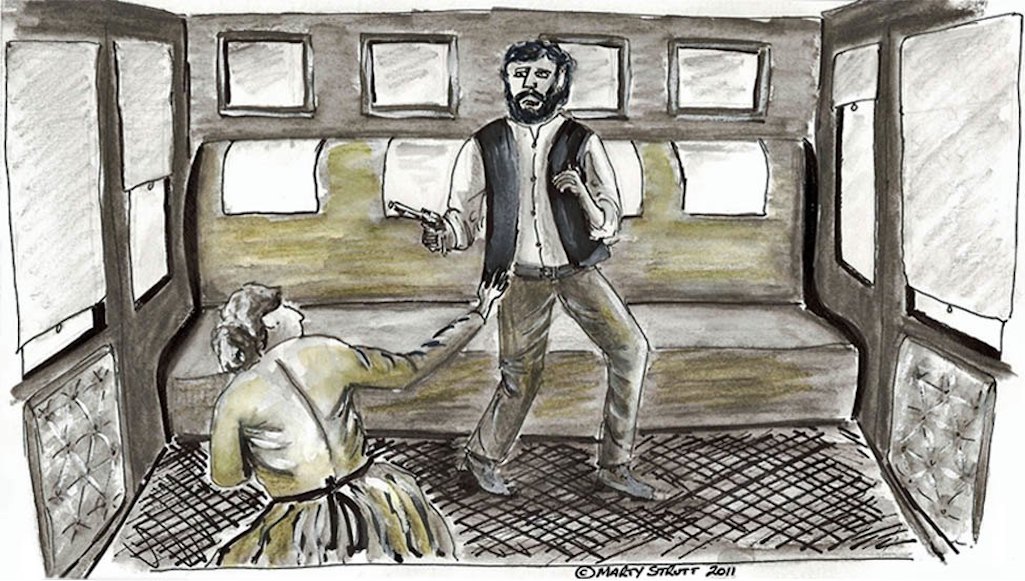
Illustrator Marty Strutt depicts the moments prior to Robert Wanless shooting his wife Ann on a train

Illustrator Marty Strutt depicts Robert Wanless about to shoot his wife

The moments prior to Robert Wanless shooting his wife Ann on a train
The coroner's jury decided that Robert Wanless had shot his wife and himself while in a state of 'unsound mind, caused by jealousy, family difficulties and blighted propects'. The jury also called for a means of communication in every train after Thomas Young reported that he wasn't able to contact the guard after hearing the shots. Witnesses also testified that Wanless was a drunken brute, obsessed with the notion that his wife was seeing another man. Three children were orphaned by his actions.
Irish Terrorism in Sutton
On November 16th 1868, William Gladstone ended a parliamentary election campaign in St Helens at the Volunteer Hall. He was just days away from the first of his four spells as British prime minister and he warned a crowd of 2,000 that "dangerous discontent" existed in Ireland. Irish loyalists would later describe this speech as "infamous" and the precursor to what they perceived to be a course of opposition and persecution of them.Fifteen years later, during Gladstone's second period as prime minister, Sutton became embroiled in a nationwide terrorism scare which The Times newspaper reported as a 'very grave' Fenian plot. It seems that the Liverpool police had received intelligence that explosives were being sent over from Ireland. So on March 20th 1883, they arrested Irishman Denis Deasy after he had disembarked from a steamer from Cork with a 'package of nitro-glycerine in his possession, and with the constituent parts of one or more infernal machines'.
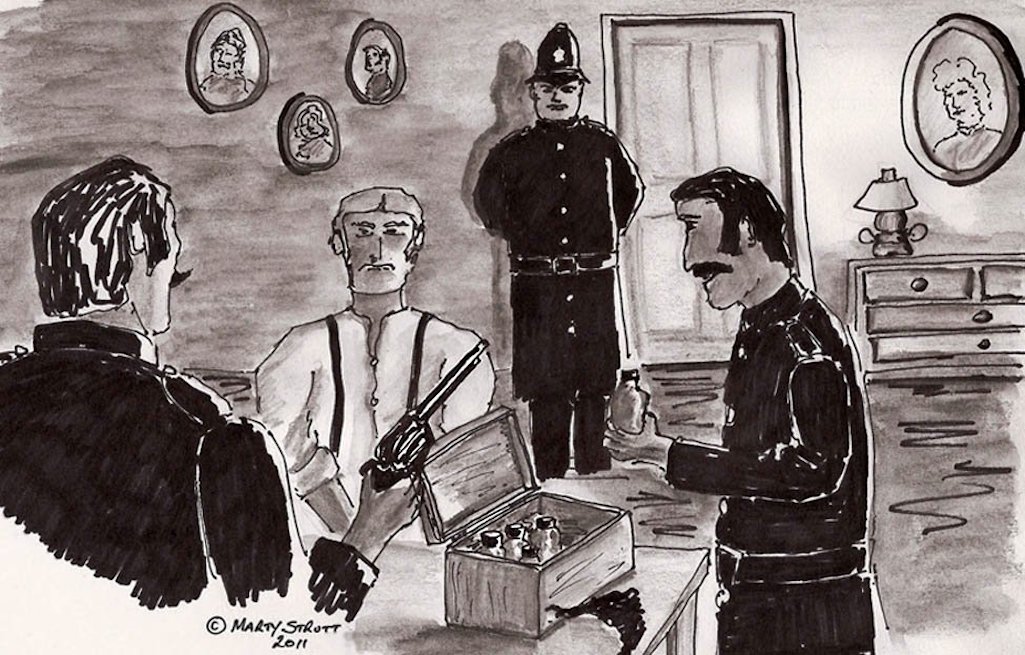
Illustrator Marty Strutt depicts the moment in Convent Row, Sutton when the game was up for Patrick Flannigan

Marty Strutt depicts the moment when the game was up for Patrick Flannigan

The moment in Convent Row when the game was up for Patrick Flannigan
On March 31 and then April 7th, Flannigan and Deasy were brought before Liverpool magistrate Mr. Raffles to face charges of possessing 'certain dangerous explosive substances'. It was supposed that their intention had been to blow up St Helens Town Hall or some other public building in the vicinity. Earlier in the year a gasometer in Glasgow had been blown up and there'd also been an explosion outside an office of the Times in London, so there was considerable tension.
The Times published an article on April 7th under the heading 'The Discoveries of Explosives' which rather intemperately blamed the dynamite plot on the 'scum of the London Irish at the bidding of American emissaries'. The article explained how the conspirators had taken lodgings in quiet places. Sutton in 1883 was at its industrial peak and not exactly quiet, but still not bad cover for a sleeper member of a terrorist cell!
Patrick Flanagan, Denis Deasy, Timothy Fetherstone, Henry Dalton and Daniel O'Herlihy were charged with levying war against Her Majesty and on August 10th 1883 after a three day trial were found guilty and sentenced to penal servitude for life. Curiously just nine months before the police searched the lodgings of Patrick Flannigan, a man living in Watery Lane had received similar treatment in another 'Fenian scare'. On June 24th 1882, Sutton was alive with rumours that boxes of arms and ammunition had been sent to the man at the Sutton Rolling Mill where he worked. The police searched his home but only found hats and clothes that his brother in America had mailed him.
Midnight Coup in Lancashire
Irish extremists returned to Sutton in June 1922 when in a coordinated series of strikes, armed Irishmen stole detonators and explosives from Sherdley Colliery, Sutton Manor Colliery, Clock Face Colliery and Bold Colliery. St.Helens Police said that they were young 'Irishmen working in concert' dressed in dark suits and light grey caps.They also raided Pilkington's stores at Ravenhead and attempted without success to break into the explosive stores of the Greengate Brick & Tile Company in Thatto Heath. Lea Green railway guard Gus Jenkinson was on his way home from work when he disturbed the raiders and was held at gunpoint for an hour until they fled empty handed after failing to penetrate the store's iron doors.
Just what the purpose of the raids was, we shall probably never know, as the British Army were in the process of evacuating from Ireland as a result of the Anglo-Irish Treaty. By June 1922 armed confrontations were taking place between those in favour and those against the terms of the agreement with the British, namely the exclusion of Northern Ireland from the newly-created Irish Free State. Soon Ireland would be plunged into civil war, so perhaps the explosives went across the Irish Sea to be used in the deadly internecine conflict that cost so many lives.
'Indecent Behaviour' in a Churchyard
In 1896 a former curate at St.Nicholas Church and nephew of the first vicar of Sutton parish, the Rev. John Vallancey (1842 - 1906), was convicted in a Derbyshire police court of 'indecent behaviour' in his Rosliston churchyard. Newspapers reported that Vallancey was fined £2 by magistrates for brawling and was also alleged to have threatened a man called Joseph Wright with a revolver, saying "I'll shoot you, I'll shoot you". The Times in their three reports published between August 1896 and April 1897 added that the cleric had also torn flowers from the grave and then had 'danced on it'.The incident took place after a lengthy dispute over the tending of a grave that contained the remains of a Mrs. Veal. This had a grass mound instead of a headstone, upon which flowers were often placed by the deceased's sister. If Mrs. Veal's family had elected to have a headstone, then Rev. Vallancey would have been entitled to charge an additional fee. So when he discovered that the family were visiting the grave and placing flowers on the mound, he accused them of trespassing and unsuccessfully brought a court action for damages. Matters came to a head on June 13th 1896 when in the presence of the Veal family, Vallancey ordered his sexton to level the grass mound with a pickaxe. The bereaved family then alleged that the sexton taunted them and the vicar, who possessed a gun, made threats.
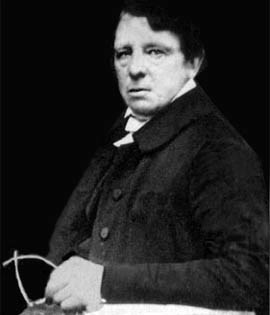
The presiding Chancellor criticised the cleric for continuing to deny the allegations and suspended him from ministering for eighteen months. He was also banned from residing within twenty miles of the parish and probably went to Devizes in Wiltshire where his wife died in 1898. However, the man who the North Otago Times (13/3/1897) of Dunedin, New Zealand said was responsible for a 'peculiarly atrocious brutality' did return to live at St.Mary's Vicarage in Rosliston and died in 1906.
John Vallancey was the nephew of the renowned Rev. Henry E. F. Vallancey (1807 - 1888), the first vicar of Sutton / St.Nicholas church in New Street, who served his parish for a remarkable 39 years. He'd ministered at his uncle's place of worship for a number of years living at lodgings in Jubits Lane before moving to parishes in Bedfordshire and Derbyshire. Searches of microfiched parish records kept at St.Helens Local History & Archives Library, reveal that John Vallancey conducted numerous christenings, marriages and burial services for his ageing uncle.
In 1888 he and niece Agnes Vallancey and fellow nephew Capt. T. E. Vallancey were chief mourners at Henry's funeral which was also attended by Sutton dignitaries Eleanor Hughes of Sherdley Hall and William Blinkhorn JP. The St.Helens Reporter of 28th September 1888 described the service as being of 'quiet and apprehensive character'. This description probably did not apply to HEFV himself who had a reputation as an indomitable figure in Sutton.
Two Candidates for the Ragged School or Gallows
Compassion and understanding could be at a premium in St.Helens police courts during the early Victorian years. For example, it was a criminal offence to be a 'lunatic' or attempt suicide and offenders could be dealt with quite sternly. In a St.Helens Newspaper article entitled 'A Lunatics Electric Shock' of October 3rd 1899 it was described how a man named John Isaac Duxbery of Nook Lane, Sutton had been brought up before magistrates Leach and Sharples on a charge of being a 'lunatic at large'. They also reported how Dr. Edward Casey of Junction Lane had a prescription to ameliorate his condition:In February 1856 two Sutton brothers John and Robert Parry, aged twelve and ten years old respectively, were convicted of stealing potatoes from a Mr. Baxter. The St.Helens Intelligencer of March 1st 1856 reported that:
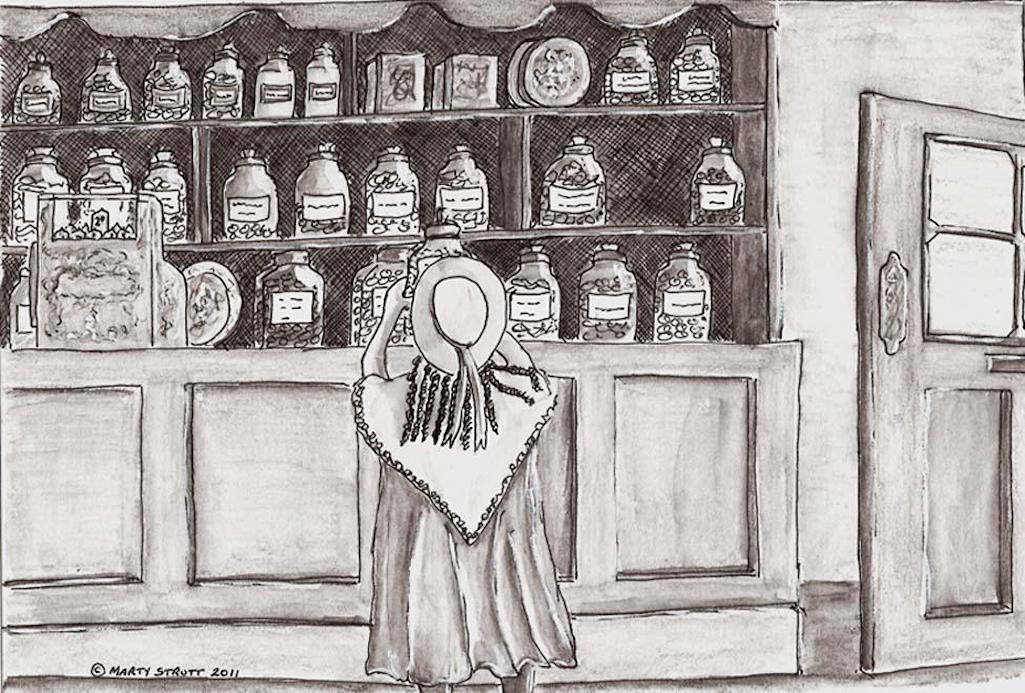
Illustrator Marty Strutt depicts little Cathy Carroll helping herself to Mrs. Reid's sweets jar in Worsley Brow

Illustrator Marty Strutt depicts little Cathy Carroll helping herself to Mrs. Reid's sweets jar

Cathy helps herself to a sweets jar
In court her mother Mary, told the bench that she was a good girl who hadn't done anything like this before and so she was dealt with leniently under the First Offender's Act and bound over. The act had the phrase 'conditionally released upon probation of good conduct' enshrined within it and is seen as the precursor to the creation of the probation service in 1907, when the Probation of Offenders Act hit the statute books. Incidentally the 'open all hours' grocers was owned by 29-year-old George Reid who bought it off his brother-in-law James Leigh, who had run it at 14 Worsley Brow for some time. It hadn't always been a successful enterprise, however, as in 1883 previous owner Edwin Challinor had been forced to place the grocer's business into liquidation.
Trouble at the Rolling Mill
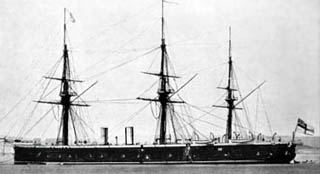
Sergeant John Bee (c.1826 - ?), was born in Rawcliffe in Lancashire and had been placed in charge of Sutton's bobbies for a number of years, prior to being knifed by Arthur Corke (c.1857 - ?). The latter was a nineteen-year-old sailor who a few weeks earlier had gone absent without leave from HMS Achilles while it was at anchor in the Mersey.
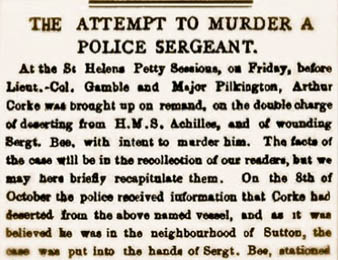
Whatever the reason, he deserted from the ship and found work in Sutton's Rolling Mill off Watery Lane. However, his workmates soon learned of his secret and Corke realised that his days were numbered. On Monday 9th October 1876 he told his colleagues at the works that he was planning to 'make it hot' for any policeman who attempted to take him and he then proceeded to sharpen a knife in front of them.
Sergeant Bee received information of the deserter's presence at the works but was clearly not expecting any trouble as he turned up on Tuesday 10th without any back-up. The sergeant arrived at the factory's office around noon and Corke was sent for. Upon seeing the police officer he took a bottle out of his pocket and drank from it. According to the St.Helens Newspaper's report (31/10/1876) Corke then said to Bee:
Sergeant John Bee seems to have taken early retirement as a result of his injury and within five years is recorded as running a grocer's in Preston. The Rolling Mill tavern in Watery Lane took the name of the works and I expect the tale of the deserter sailor who tried to murder a local bobby, was often told over a jar or two.
Raid on the Sutton 'Tossers'
The summer of 1916 is remembered for the start of the Battle of the Somme, one of the bloodiest ever military operations. The St.Helens newspapers were full of reports of the Great War, with many pictures of casualties and captured men. Never had the St.Helens Newspaper and Reporter used so much photography in their papers, albeit posed studio pictures. They proudly profiled the 'patriotic' St.Helens families who had as many as half-a-dozen members, including fathers and sons, fighting at the front.However, for the Sutton bobbies who weren't called up, it was business as usual. They continued their own law enforcement war, rigidly enforcing all statutes and making no concessions for the hostilities in France and the worries of the combatants' families and friends back in England.
For example, when Sgt. Adams was doing his rounds in Junction Lane on May 20th 1916 at 10.37pm, he found the Sutton Empire still showing a film. They were only licensed under the 1909 Cinematograph Act to exhibit films until 10.30pm and the manager's explanation that the cinema had had a technical breakdown, fell on deaf ears. The 'Sutton Bug' operator was moving the film by hand attempting to conclude their Saturday evening entertainment and keep their patrons happy. Sgt. Adams was unmoved and on June 9th, the St.Helens Newspaper reported that the Sutton Picture Company had been fined £1 by magistrates 'to warn others that the law must be carried out.'
The gambling laws were similarly enforced by the St.Helens police with great rigour, even the simple pursuit of pitch and toss. Although played with different variations, it usually involved two coins being tossed with one member of the group or 'school' choosing 'heads' and another 'tails'. There was a winner if the coins both come down heads or tails, otherwise stakes were 'rolled over' to the next toss.
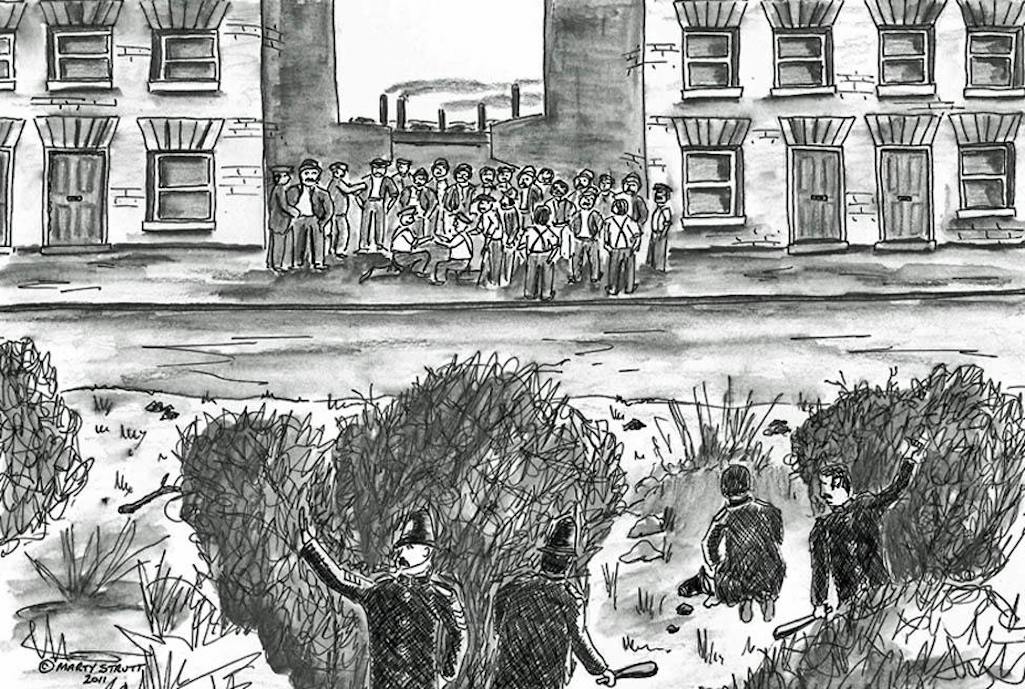
The police get into position in Rolling Mill Lane, just waiting for the ice cream cart to arrive before raiding the gamblers

The Sutton bobbies are depicted by illustrator Marty Strutt getting into position in Rolling Mill Lane, just prior to raiding the pitch and tossers

Sutton bobbies get into position in Rolling Mill Lane prior to the raid
He observed the 'gang', as they were referred to in court, for over two hours tossing coins and playing handball. Around 4.40pm Frederick's ice cream cart drove up and all the men bought ice cream. Sgt. Bate seized the moment and with his quarry distracted, he moved in with his constables and raided the unsuspecting group. In court all but two were convicted and they were each fined thirty shillings or fourteen days in prison. Pitch and toss was the most common form of coin gaming and was especially popular with Sutton mining communities, where it had been played since the 18th century. The pursuit rapidly declined from the 1950s with the onset of TV and the spread of other forms of entertainment.
The Drunken Hearse Driver
These days with breathalysers and blood tests, it's not too difficult to evidence a heavy alcohol consumption. In days past, proving drunkenness was often one man's word against another with defendants in court regularly claiming that they'd only supped a glass or two. There had to be corroborative evidence from witnesses, especially police officers or a previous history of drunkenness before magistrates were minded to convict. After all drinking was endemic during the latter parts of the 19th century.When Police Sergeant Jackson arrested Peter Lees, the landlord of the Coppersmith Arms in Watery Lane on July 4th 1896 for being drunk on his own licensed premises, he claimed in court that he'd been completely sober. He admitted having a couple of glasses a few hours earlier to celebrate the Sutton Rose Queen Festival but that was all. As this was the first time he'd been in court and without witnesses to corroborate the Sergeant's story, the case was dismissed. However, 36-year-old hearse-driver Frederick Ridgway was not so fortunate when he appeared before St.Helens magistrates on 27th June 1881, charged with being drunk whilst in charge of a horse and carriage on the highway at Sutton some three days earlier.
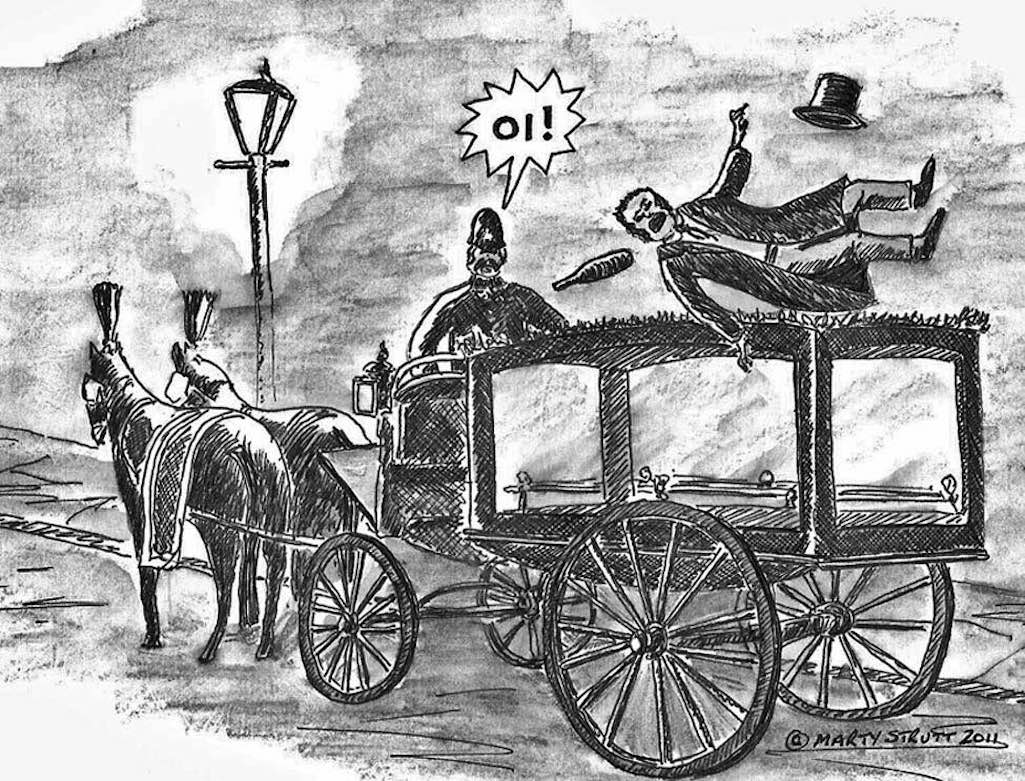
Illustrator Marty Strutt depicts how Frederick Ridgeway jumped out of his skin after being gently woken by P.C. Carter!

Fred Ridgeway jumps out of his skin after being gently woken by P.C. Carter!

Fred Ridgeway jumps out of his skin after being gently woken by P.C. Carter!
In court Ridgway said he had been "a long way in Cheshire" and at Sankey on the way back had only had one glass of beer. He also claimed not to have been asleep at all and that the police had suddenly turned a lamp on him and then jumped upon his hearse. He said he wouldn't go home because he was angry with the way he'd been treated.
However, as several police officers provided similar testimonies and as the cab proprietor had previously been fined for being asleep on a conveyance, J.P.s T. Pilkington and R. Pennington Jnr. convicted him with a fine of 10 shillings plus costs. A lot of trouble for the police for just a ten bob fine. Whether he had a customer in his hearse is not, unfortunately, revealed in the St.Helens Newspaper's account, although we can presume not. Otherwise I would have felt compelled to title this article 'Dead Drunk in Sutton'!
Shooting of a Bold Poacher
During the nineteenth century, the Sutton and Bold district was much more agricultural than it is now and so there were more rural crimes than today. With so many open fields, it wasn't too difficult to get away with nicking from farmer's fields, although the bobbies on their beats would keep their eyes open for offenders. Suspicious bulges on the persons of shifty-looking characters exiting fields would attract close attention from the Sutton boys in blue and you didn't have to steal much to find yourself in court.On October 24th 1899, Thomas Seddon was brought up before Alderman Sinclair on the Police Court bench charged with stealing 9d of cabbages. The police had caught him taking them from a field on John Price's farm near to St.Nicholas's church in New Street. 76-year-old magistrate Arthur Sinclair knew the area very well as he lived in Waterdale, just down the road from farmer Price and he gave Seddon a fine of five shillings or seven days in prison.
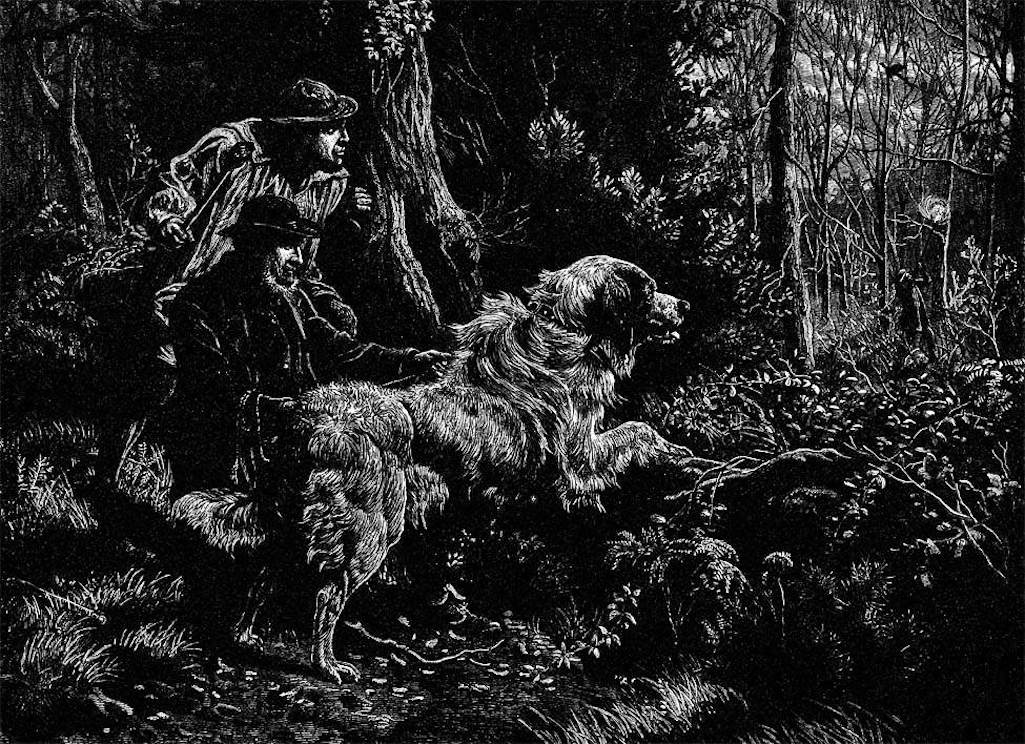
Illustration entitled 'Catching A Poacher' from The Graphic newspaper published on October 17th 1874

Illustration titled 'Catching A Poacher' from The Graphic newspaper of 1874

From The Graphic newspaper of 1874
Landowners insisted that they alone possessed the sporting rights to kill game on their land. Until the passing of the Ground Game Act of 1880, tenant farmers didn't even have the right to kill pests that were damaging their crops. When Henry Bold Hoghton of Bold Hall declared in March 1844 that his tenants would be able to shoot hares and rabbits and do what they wanted with them, it attracted some favourable publicity in newspapers. Hoghton was somewhat forward-thinking for his time. The Leeds Mercury of May 25th 1844 said he was 'a truly Honourable Gentleman' when he issued a statement that his tenantry were free to vote for whoever they chose in the forthcoming general election. This couldn't be taken for granted and Ellen Hughes was said to have instructed her Sherdley tenants during 1844 to vote for the Tory candidate.
Although Hoghton allowed his tenantry to kill rabbits and hares from September 1st 1844, the limits of this concession were made clear. For outsiders caught poaching on Bold land there would still be penalties, which might include getting shot! Four years earlier - on Sunday morning 19th January 1840 - three Warrington lads, Nicholas Timperley, James Holden and Thomas Boydell, had gathered in Penketh Lane and planned a daring pheasant shoot. At 7pm Timperley and Boydell met at the Angel Inn and then collected Holden from his home. Armed with a gun and a large stick they walked to Bold, arriving on the Hoghton estate at 10pm.
After killing a hen pheasant around half-past midnight, they bumped into Henry Hoghton's gamekeepers, led by Mr. Taylor who with gun raised ordered them to stay put. However, the trio of poachers after briefly obeying, turned on their heels and ran. So Taylor unleashed his dog on them and Holden fired at the animal, badly wounding it. In retaliation the gamekeeper opened fire on the fleeing men, bringing Thomas Boydell to the ground.
He was shot in the thigh and arm and was easily captured by the gamekeepers. Although his pals made a clean getaway, Boydell gave their names and addresses to the Warrington police, who picked them up next morning. Being shot was considered sufficient punishment for Boydell who gave evidence on behalf of the prosecution at Timperley and Holden's court hearing and the pair received three months imprisonment in Kirkdale jail in Liverpool.
The magistrates cautioned Taylor, the gamekeeper, against "firing at parties he might detect in the act of poaching in future". Although Taylor claimed he fired at a distance of some 60 yards after having his dog shot, the J.P.'s said "that was not justification for his shooting at a fellow-creature". He was warned that he would have been prosecuted for manslaughter if Boyden had been killed, although there were no charges for wounding. Of course, confrontations between armed poachers and gamekeepers at the dead of night were inevitable and there were numerous incidents nationwide during the 19th century, that led to a number of deaths on both sides.
The Great St. Helens Railway Robbery
The phrase 'Great Train Robbery' is very much associated with the twentieth century, most notably with Edwin S. Porter's 1903 film of the same name, and sixty years later, the renowned Buckinghamshire train theft, which at that time was the biggest ever heist. However as far back as 1865, Sutton had its own Great Railway Robbery, as the newspapers dubbed it. Unlike the film production based on Butch Cassidy's 'Hole in the Wall' gang who in 1900 stole $5,000 from a train and the 1960s robbery in which £2.6 million was taken, Sutton's version was much more modest. In fact the ill-gotten gains from a train at St.Helens Junction amounted to just 30 pairs of ladies boots and 34 flannel shirts! Oh, and some 'trusses' of corduroy too.Despite this, the coverage in the St.Helens and Liverpool press was extensive and was spread over a period of weeks. A report on the committal hearing for the six suspects that was held at St.Helens Town Hall, almost filled a full page of the St.Helens Newspaper's July 11th edition and a week earlier they'd reported that:
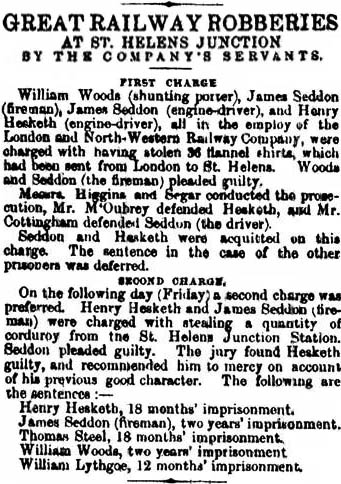
A number of railway employees were singled out as being likely candidates and six were arrested and their houses searched. Driver James Seddon was 'nicked' at St.Helens Junction and others who were taken into custody included shunting porters and firemen, one of whom seems to have been Seddon's own son James Jnr., arrested on an engine.
There were a number of court hearings in St.Helens which descended into near-chaos. An error had meant that three of the accused, who'd been granted bail, were kept locked up for a fortnight. Defence solicitor Pemberton objected strongly to this and also protested against the magistrates, who were due to adjudicate in the committal hearings. It proved quite difficult to find a J.P. who didn't have a financial interest in the London and North Western Railway Company and one magistrate was forced to stand down. Then an objection was raised by Pemberton against William Pilkington Jnr. conducting the hearing.
Pilkington admitted that he was "connected with one who had a large amount invested in the concern". He added that the only other magistrate available to consider the case had the largest investment of all the J.P.s in the train company. So Edward Johnson, law clerk to the Commissioners was summoned and he gave a legal judgement that Pilkington could adjudicate after all.
Within a fractious atmosphere, Alfred Lee, the station master at St.Helens Junction, gave evidence that on May 30th 1865, wagon 10803 had been kept in a Junction siding overnight. This was normal practice for goods trains that had been delayed and it presented easy pickings for the accused, who were serving the 11pm to 6am night shift. There were a number of separate charges that each man faced and some pleaded guilty and had named others. After being committed to trial at Kirkdale in Liverpool, five railway staff from St.Helens Junction were found guilty and sentenced to between 1 and 2 year's imprisonment.
Despite engine driver Henry Hesketh being cleared of one charge and the jury recommending mercy after convicting him on a second, he was still given an 18 months sentence. A message was clearly being sent out by the judiciary, of whom many members owned shares in the railways, that they would no longer tolerate this level of theft from the trains.
The Attempted Axe Murder of a Stepfather at St.Helens
There was clearly bad blood between 25-years-old Dennis Woods and his stepfather James Oates. After the death of his father, Dennis's mother Catherine had married a man about the same age as her eldest son. They lived together at 57 Nook Lane, Sutton, along with four other sons, a daughter and a boarder. It was very common for wives and husbands with young children to quickly remarry after the death of their spouse. The widows needed an income and widowers needed a woman to care for his children and keep house.
Perhaps Dennis - who like his father worked at Sutton Glassworks - resented being told what to do by his young step-Dad? The motives for his actions aren't recorded but it's easy to speculate in a claustrophobic household. What is known is that on Saturday June 21st 1890, the stepfather James spent an evening out drinking.
He returned too late for his Irish wife's liking and they had a row. Catherine was twenty-one years older than her husband and probably wanted him to spend more time at home. For some reason James proceeded to remove his coat, vest and trousers and threw them onto the fire. Soon after this, his stepson Dennis returned from his own Saturday night out and went to bed. James Oates then put on an old pair of trousers, lay his head on the table and went to sleep.
Just before 3am, Woods rose from his bed and collected an axe. He walked behind his sleeping stepfather - who still had his head on the table - and gave him two blows, leaving the axe embedded in his head. Woods then left the house and about twenty-five minutes past three, knocked on the door of the Sutton Road police house. He startled Sgt. Brooks by saying:
I have come to give myself up. I have murdered my step-father. I have killed him as dead as a doornail. I struck him twice on the head and left the axe buried in his head.
However when Sgt. Brooks arrived at Nook Lane, he found Oates still alive but with two severe wounds to his head and much spilt blood. Woods was taken to the Town Hall and charged with attempted murder. He told the police that he wished he'd killed his step-father, so that he would be hung. Just before Woods appeared in St.Helens Police Court, his mother Catherine had what the Liverpool Mercury described as a 'fit' in the witness room. She clearly was another victim of the attack. However, James Oates eventually recovered from his wounds and resumed his work as a miner.
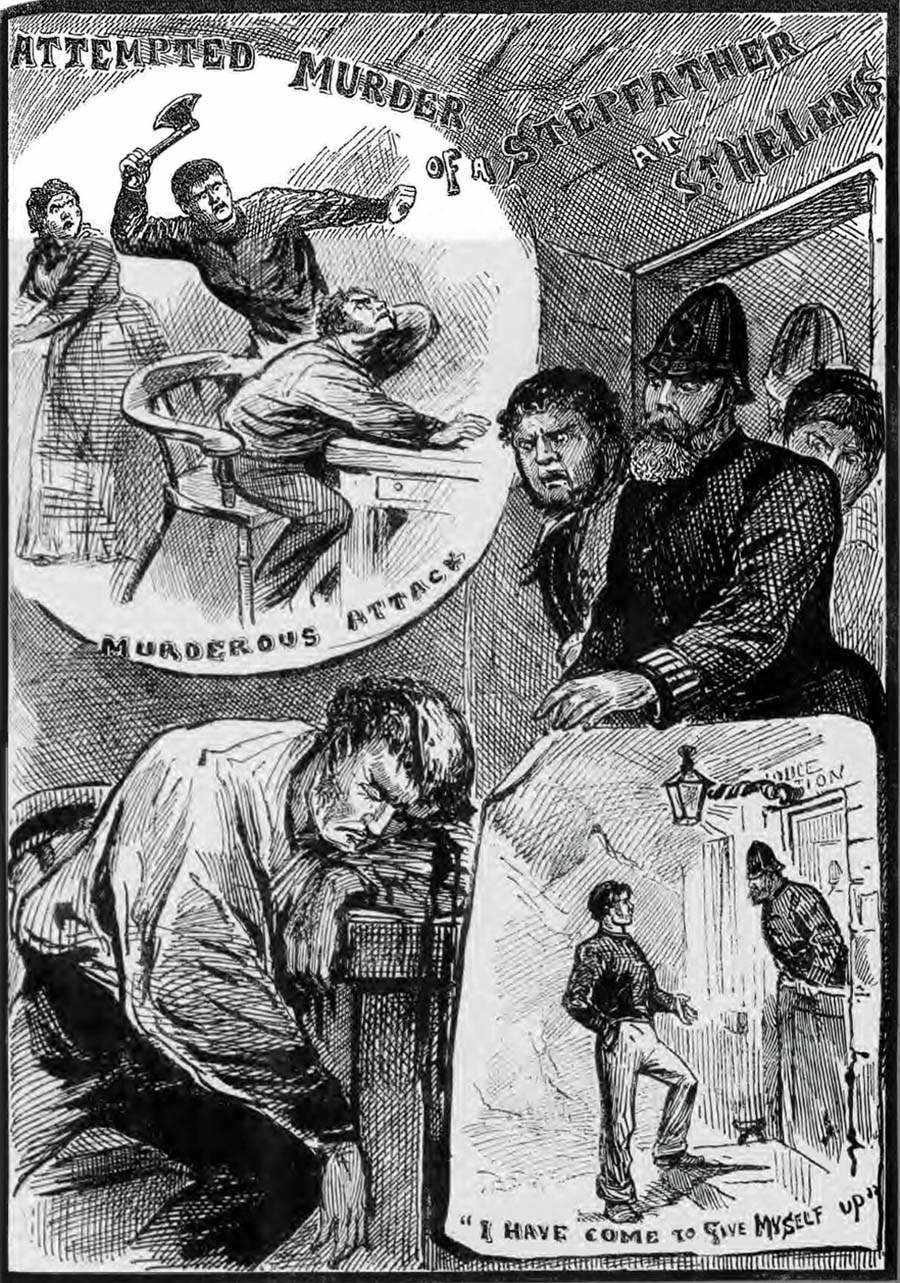
Illustration of the attempted murder in Nook Lane, Sutton in the lllustrated Police News of July 5th 1890

An illustration of the attempted murder in the lllustrated Police News

An illustration of the attempted murder in the lllustrated Police News
The story was covered by the Liverpool Mercury and repeated word for word by the Illustrated Police News a week later, without crediting the source. However they added a sensationalised illustration with mother Catherine watching her son's shocking act. In reality she was in bed and probably unaware of what had happened until the police arrived. Their artist even depicted the outside of Sutton police station within the montage of images.
If you visit The Victoria pub in Chester city centre, you'll see the newspaper account complete with graphic framed on a wall. The Illustrated Police News, Law Courts and Weekly Record - to give it its full title - had nothing to do with the police. It was a popular Saturday penny newspaper that specialised in cheap true stories of crime and accidents. They covered St.Helens on a number of occasions and two weeks after the Sutton story, they featured an illustrated version of a murder in Rainford.
On July 31st 1890 at Liverpool Assizes, Dennis James Woods pleaded guilty to wounding with intent to cause grievous bodily harm and was sentenced to five years penal servitude.

Illustration of the attempted murder in Nook Lane, Sutton in the lllustrated Police News of July 5th 1890

An illustration of the attempted murder in the lllustrated Police News

An illustration of the attempted murder in the lllustrated Police News



